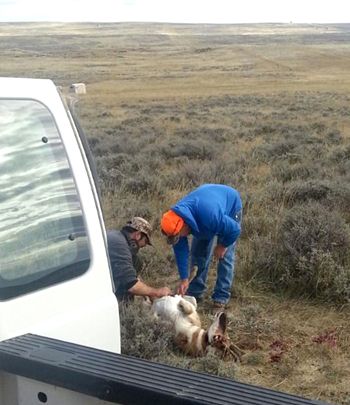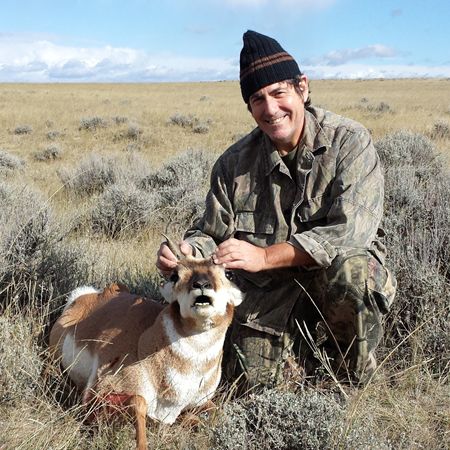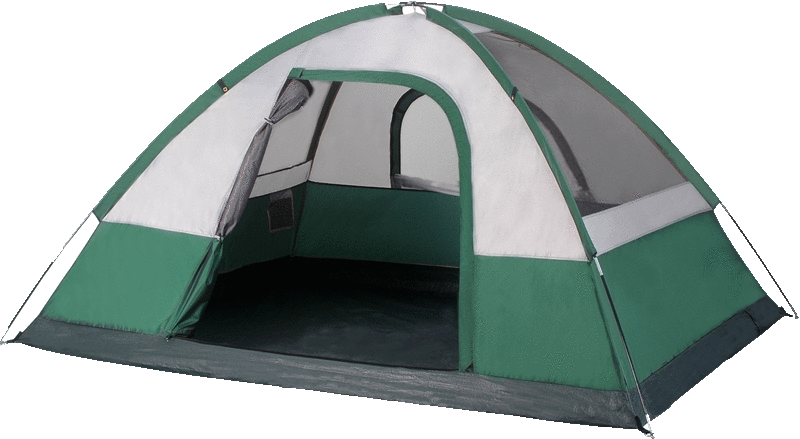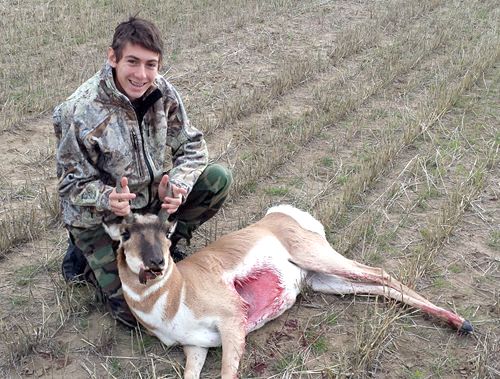We needed a first big game hunt for the boys, and after pondering
the situation I came up with the idea of an antelope hunt in Wyoming. I had
hunted a ranch several years before and still had the contact information.
After flailing around with the logistics of when the boys were out of school
and when the adults had to get back to work, I contacted Marty at the ranch
and reserved a spot for six for the second weekend of antelope season.
Through a convoluted series of events, the plan was for four of us to fly from
Phoenix to Denver, drive to Casper, overnight it at a hotel, meet with the other
two driving from Spokane, then drive to the ranch the next day.
I must take the moment to whine about the relatively recent change in airline
baggage policy. It appears that almost all airlines now have around a $200 per
leg charge for oversize baggage – like a rifle case. Hmmm, $150 plane ticket
with $400 of baggage charges just doesn’t seem right. `Nuff said.
The plan actually came together without major incident, and all six of us
arrived at the ranch at the appointed hour. It started to drizzle and the
wind picked up to gusts of 20 mph just as the weather report said it would.
As the boys scurried around to get their gear together, don the orange and
jackets etc., a tall lean ranch hand sauntered up. It was Marty. He had
arranged for himself and another ranch hand, Tim, to guide us. After a bit
of discussion, we decided to have Doyle and his son Bailey (from Spokane) go
with Marty, while the rest of us went with Tim.
Tim is an affable sort with a good sense of humor and the eyes of a hawk.
Many of our conversations went like,
“See those antelope over there, the last one in line has a crooked horn.”
“Where?”
“Over there.”
“You mean like 600 yards over there?!”
“Yeah, those.”
Sheesh. My eyes aren’t the greatest, but this guy was giving me a complex.
And the funny thing is, after sneaking up on them, Tim was right. Always.
Tim was driving a white crew cab pickup, and the basic arrangement was one
person in the passenger seat (who was the primary shooter), two in the back
cab (moral support and spotting), and optionally one riding on the hay bale
in the back (spotter) or in the back of the cab with the other two. Nobody
wanted to be first up, so Jim and his son Jamison as well as my nephew all
squeezed into the back cab while I jumped into the front passenger seat.
As we drove off, the rainy drizzle stopped and the wind died down a bit.
A good omen.
A quick word on the hardware our little group carried. Jim had a semi-auto
.30-06 with several 4 round magazines. Jamison had a lever action 30-06,
and Matthew a single shot break open .30-06. I however, had an axe to grind.
I had carried this particular rifle on 3 hunts without ever taking a serious
shot. The first was an elk hunt (only saw deer), the second a deer hunt
(only saw a cow elk), and the third an out of desperation shot at a javelina
(what the heck, at a running javelina over 200 yards away). I was blasting
something this time dammit! And the caliber of my cannon: .338 RUM.
After driving a spell, and laughing at a couple of Wyoming type jokes, Tim
spotted the herd that prompted the conversation above. I’ve always wanted
an atypical rack, so I told Tim I’d try to take the last antelope with the
goofy horn. We drove a bit more, got out, and started a bit of a stalk.
Given the entire herd was watching us from the side of the hill they were
on, I quickly surmised the stalk wouldn’t go much further. As I started to
set up my shooting sticks, Jim mentioned he’d back me up if I missed. Fair
enough. As I was setting up, the herd looked like it wasn’t going to stay
around much longer.
I had left my rangefinder in the truck, and asked my esteemed colleagues
what the range was. I will be the first to admit that I am terrible at
judging distances, and a rangefinder is a must for me at any appreciable
distance. Funny thing about antelope and Wyoming though, I’ve never had
good results with rangefinders there – I’ve never found one that reads
reliably past 350 yards. I don’t know why, but I suspect there’s something
about the antelope coat and sage brush just doesn’t seem to reflect a laser
very well.
Anyway, I heard, “425”. That was okay for me; I’m max point blank out to
about 350 so 425 is not much of a hold over. Goofy horn paused broadside
a moment, I put the cross hairs right on the top of the shoulder and let
it fly. Yep, cleared the shoulder by about 6 inches. Hmm. I heard Jim
shoot a few times immediately afterward and old goofy horn just kept on
running.
“Did anyone try the rangefinder?”
“No, we were just guessing.”
AAAaaaarrrrrrggghhhh.
Remaining undaunted, we all squeezed back into the truck and sallied
forth once again. A bit more romping about the prairie, and we found
ourselves on top of a hill peering at a large herd way off in the
distance. As we were trying to figure out a way to get to them,
Jamison asked, “How about that one over there?”
Sure enough, in the opposite direction was a solitary antelope buck
standing in the middle of an empty field. The rangefinder said 250.
This was good news because I had Jim and Jamison practice on a rock
at 260 at the Table Mesa Road spot. Jamison quickly set up on the
sticks and pulled the trigger. It was a good shot. In fact, it
worked out to be the best shot of the bunch. Right behind the
shoulder and right about the midline. The antelope walked about
10 yards and fell over dead.
A quick jaunt in the truck, and we set upon the downed antelope.
Jamison had field dressed his first game animal (a javelina) a few
months prior, and it was time to scale up a little bit. With a bit
of encouragement, pointing, and lots of grunting from the sidelines,
he managed to get the field dressing done and the antelope into the
back of the pickup.
A bit more driving, and we were on another herd. This time, the herd
ran around the hill to our right. We stopped and started a stalk.
What we found was a deep bowl on the other side of the hill with a
riser almost as high as the hill. No antelope. We decided to drop
down into the bowl, go up the other side, and see what we could see.
After a few words of wisdom about not silhouetting one’s self to the
boys, we were off. As we peeked over the top of the bowl, we saw a
herd of about 30 spread out on the next hill at about 200 yards (yes,
using the rangefinder). My nephew was to my right, and Jim and Jamison
were about 10 yards to his right.
It was steep enough, so I told my nephew to rest his rifle on top of
the berm in front of us and take the straggling antelope near the
bottom of the hill on the left. He was taking too much time, and as
I turned to look at him and tell him to shoot, I heard Jim rack the
action on his semi auto…. All the antelope also heard him rack his
action and took off running. Looking further over, Jim had forgotten
about silhouetting himself as well and was just blazing away. Pancho
Villa was born.
Continuing on, we searched the prairies for more antelope. Several
herds were spotted, but they were either too far away, or ran before
we could get within reasonable range to start a stalk. As we rounded
a corner two antelope were standing on the “road”. They took off
around the back side of the hill to the right, and we jumped out of
the truck. We lined up, more or less, and headed up the hill. Jim
and Matthew were to my left, and Jamison to my right. As we crouched
and made it to the crest of the hill, I saw nothing — for miles in
all directions. As I was standing up a bit more, Jamison started
pointing down the hill and a bit to my left. I saw the tops of two
sets of horns, and as I finished standing up a bit more, the
antelope saw me as I saw them. They were indeed on the bottom of
the same hill we were on. Seeing me, they did as antelope do – run!

|
They ran back to the left, basically whence they came and were
quickly out of my sight. That meant they were headed into Pancho’s
and Matthew’s view. I started running along the top of the hill to
my left, and as I made it near Matthew, I heard Jim shooting. By
his third round I could see the two antelope on the side of yet
another hill. They weren’t running full speed any more, but were
more than walking. As I thrust my shooting sticks to the ground, I
had to guess they were at a bit over 400 yards. No time for a range
finder. Jim had gone silent, and I presumed he was slamming another
magazine into his rifle. I drew a bead on the antelope on the left,
guessed its speed, aimed forward and high and pulled the trigger.
Ka-Boom! The .338 RUM is not subtle. I looked at that far hill,
and only saw the antelope on the right; it was running away over
the hill as Pancho blazed away another 4 round magazine. Jamison
walked up to me and said, “Man, yours just face planted!” I was
worried about meat loss with the cannon, but at that range and on
the move frankly I was happy and surprised I hit it.
Tim had seen where the antelope went down (of course) and we piled
into the truck once again. As we drove essentially straight over
there, we pretty much verified the distance was indeed around 400.
Tim stopped the truck, pointed, and said, “Over that way about 40
feet.” I jumped out of the truck and headed that direction. As I
got to about 30 feet, I saw something strange fluttering / waving
about just above the sage. Hmm. When I got there I saw the
antelope, down on its side and flopping about. It had an arrow
through its neck and the fletchings were waving about above the
sage! What the?! The antelope was obviously not getting up, and
there was no blood on its neck. The arrow was intact with about
half sticking out of each side. By this time Tim had caught up.
He said,
“Oh! That’s the one from archery season, we’ve been trying to get that one.”
“How long ago was archery season?”
“About a month.”
Sheesh. As the antelope continued to flop around I noticed something
else. There was no blood anywhere! As I kept looking I finally
noticed that there was a .338 caliber hole through the right horn
about 1” above the skull and the horn was hanging by a thread. Holy
moly! Evidently I had shot it through the horn and brain damaged it
to such a degree that it wasn’t getting up again. I took the 30-06
from Matthew, and one more shot to the cortex ensured it wasn’t going
to flop around anymore either. I took a moment to give thanks for the
kill and then proceeded to get the field dressing done.
Two down and two to go. More driving and spotting. Again, in a bit
of strangeness, we rounded a corner and there were two decent size
adult males fighting - it was the rut after all. As the truck did a
mini power slide to a stop, I ranged them at 49.7 yards. Wow! Jim
scrambled out of one side of the truck, and Matthew the other.
Matthew was just a bit slow, and as he was setting up his shooting
sticks (wrong move at 50 yards) Jim used the corner of the truck and
blazed away. His first shot hit the antelope on the left, and as
they broke away and ran, his fourth shot hit it again. So much for
letting the boys get the first shot…. Anyway, we had another
antelope down and the field dressing commenced.

|
Jim doesn’t have a whole lot of experience field dressing, so it
took him a few minutes with some pointers from us bystanders. While
we were doing this, the cattle came in to take a closer look, as did
a couple of antelope. They were yearlings and not candidates for
the BBQ, so we just watched to see how close in they would come before
they realized we were disemboweling one of their cohorts. About 10
yards. By this time, I was getting the idea that Matthew wasn’t very
excited about having to field dress an antelope. Three down, and one
to go.
About a mile of driving later, we spotted two males and a yearling
relatively near the road on a flat. Further down the road was an
oil maintenance shack, so we drove to that. Funny thing about
driving a truck around the prairie in Wyoming; if it’s white the
antelope assume it’s an oil worker truck and don’t pay much
attention to it. So we drove past the antelope to the oil
maintenance shack as any good oil worker would do, and they barely
lifted their heads to acknowledge our passing.
After we parked, I grabbed my rifle and rangefinder and moved to
the corner of the shack. Matthew had the rifle and shooting sticks
and was setting up to my left. I ranged the closest antelope at
272 and turned to tell Matthew. The wind had picked up and he
didn’t hear me, but estimated the range to be about the 260 yards
we had practiced at, and pulled the trigger. By the time I turned
back to the antelope I had already heard the “slap” and knew he
had hit it. I was surprised however, to see it trotting over the
hill away from us.
“Put another bullet in your rifle, and when we crest the hill, if
the antelope has his head up, shoot him again. Don’t wait.”
“OK”
I followed relatively closely behind Matthew, and as we crested
the hill, I saw the antelope jump up at about 50 yards and keep
moving. It went directly away from us out to about 100 yards,
turned broadside and stopped.
“Shoot! Shoot! Shoot!”
Bang! Slap! The antelope went down beneath the sage. I thanked
God and told Matthew to put another bullet in his rifle and shoot
it again if its head was up. This time, I put one in mine as well.
We walked more slowly toward the antelope this time, with about
5 yards between us. Matthew was on the left, and I was on the
right. Both of us ready to shoot. Again, when we were within
50 yards of the antelope, it jumped up and was moving directly
away from us. Oh Christ…. I heard Matthew shoot as I brought
the cross hairs down to the base of the antelope’s neck. Matthew
had missed but it was still moving directly away. As I pulled
the trigger, the antelope lurched over a sage brush and I saw its
hind quarters rising in my scope. All I had time to think was,
“Oh no! Texas heart shot here we go.”
The RUM roared and the antelope went down in a heap. Matthew
now had to face up to the unpleasant task of his first ever field
dressing. It took a while, but he did very well. In the end he
was fully initiated by cutting himself before he was done. One
band-aid later and the last antelope was in the truck.
As we field dressed the antelope, I confirmed that it truly was
a Texas heart shot; the round went through the right rear cheek,
traversed all the way through and exited at the base of the neck
leaving a golf ball sized hole. As expected, everything internally
was blown up – leg and hip shattered, tenderloins bruised, guts
throughout, and fragments through the heart. Sheesh. I mentally
predicted that not much was going to be saved on this one.
We got the antelope back to the ranch, and the skinning and
quartering began. All the animals were in coolers within an hour
or so. The brain damaged antelope had no meat damage whatsoever,
and the bionic antelope yielded the largest set of horns. Matthew
had shot the left rear cheek with his first shot, and went through
the right front leg (but missed the vitals) with his second. That
combined with the cannon damage yielded a left front leg in addition
to the horns.
Final round count: Jamison – 1 (winner!), Roger – 3, Matthew – 3,
Pancho – 16. The experience with the boys was great, and they
learned a lot, not only about hunting techniques, but also about
the real work of field dressing, skinning and quartering.

![]()






